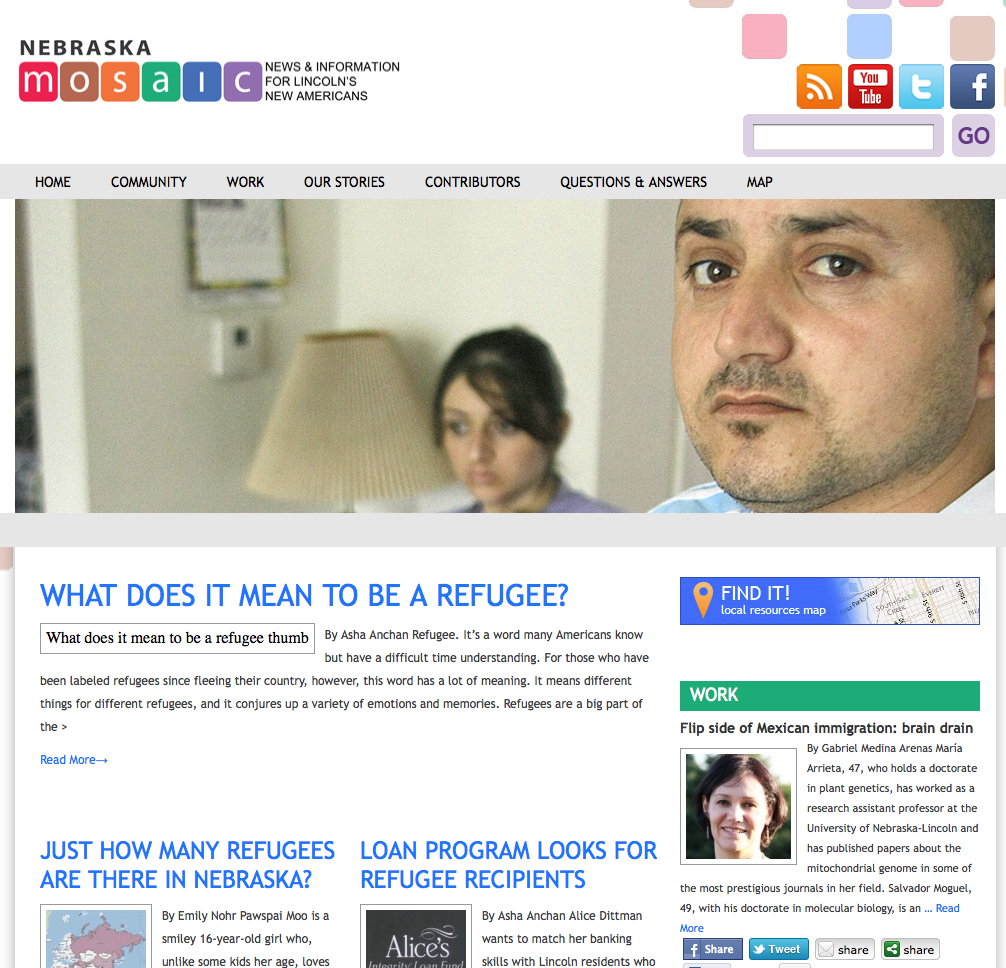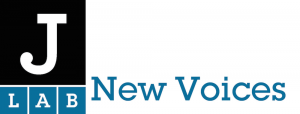By Tim Anderson
Editor
Nebraska Mosaic has become an important part of the advanced journalism curriculum at U-Nebraska’s College of Journalism and Mass Communications. More to the point, it’s a voice that represents Lincoln’s growing refugee communities.
We started out as a small project, and, though we continue to grow, we remain a small project. But we believe we are beginning to make a difference in the community conversation in Lincoln, and that we are increasingly seen as a conduit of information and news to and for the refugees who have resettled here.
History
In our original application we described our project as a website to be created “by our students to provide information for and about rapidly growing immigrant communities” in Lincoln, Neb.
We began by developing a course split evenly between students in our advertising/public relations program and our journalism program, an unusual step for the college at that time but one that we have chosen to replicate in other projects since then.
Initially, we focused on three refugee groups: Iraqis, Sudanese, and a little-known Christian sect from Burma, the Karen. This allowed us to easily manage our start-up, giving the project – and the students – a deeper reach into these communities. We have since expanded to embrace all refugees in Lincoln, though our deepest connections continue to be with these three groups.

The audience research we compiled in the fall 2010 semester provided us with valuable information regarding the news and information needs of these refugee communities. We learned, for example, refugees most desired additional information and help with language, employment, education, and transportation. We put these categories in the forefront as we began to produce content.
The research also suggested we should target high school-aged children in the refugee families. They tended to have the greatest facility with the English language, and we believed that, through them, we would have the best chance of reaching their parents. We discovered, however, that teenagers in refugee families, perhaps like all teenagers, have a long list of interests, and we were not one of them. So, they have not been the focus we thought they would be.
The first semesterʼs class contained eight advertising/public relations students and eight journalism students, the maximum size of most of our “skills” courses at the college. We believed that in subsequent semesters, once the class focused on creating content by journalism students only, we would conduct a class of roughly eight students. We have been somewhat disappointed, however, in the response from students. Those who have taken the class – seven students in the fall 2011 semester, six in the spring 2012 semester – found the class to be among their favorites, according to semester-end evaluations.
We believe the tepid response may be due to a simultaneous expansion in our elective-course offerings, giving the students many courses to choose from. We plan to use information gleaned from the student evaluations to create a more deliberate promotional campaign for the class.
Our initial ideas for support didn’t pan out, but we found an enthusiastic partner in the Lincoln Community Foundation, which worked with us in applying for a $50,000 Knight Community Information Challenge grant.
Iterate. Iterate. Iterate.
As with the teenagers and the class size, things have not always gone as we expected or hoped. Our position has been: When we hit a wall, we change direction – always keeping our focus on our goal of being the primary source of news and information for the refugee communities. Some examples:
- Refugees arenʼt interested in their own tales of woe. Being refugees, meaning they have been persecuted, assaulted or otherwise put upon in their home countries, they all have powerful personal stories. Because they all have them, however, they donʼt find them very interesting. What they desire is stories that tell them what to do to have better lives now that they are in the U.S. So, when we have told anyoneʼs personal tale, we have tried to do so from the perspective of the lessons learned that may have eased the transition to the United States, to Nebraska, and to Lincoln.
- Refugees are, for the most part, very poor. These people have three strikes against them: They are unwanted in their home countries, they have come to a country where many of them donʼt know the culture or the language, and, once here, they immediately join our poverty underclass. Their level of poverty leaves them focused on employment for themselves and education for their children, leaving them little time and interest in participating in our web project.The Lincoln Community Foundation partnership is focused on expanding the project beyond the college classroom, specifically into the refugee communities, inviting the refugees themselves to help create content. This has been difficult. But we kept trying different approaches, until discovering that a $50 freelance fee made all the difference. (Our discovery came when an Iraqi man, whom we had asked to write his story for the website, asked, “Will you pay me?”) We have now published articles from two refugees, one from Iraq and another from Congo, and we have two more currently being edited, these from refugees from Sudan and Vietnam.
- Refugees are mostly low-tech for now. Our initial research suggested refugees were big cellphone users, and this led us to believe we would quickly find a way to utilize mobile technology as part of the project. Further research, however, indicated that they have low-priced phones used only for phone calls back home. Ownership of smart phones is exceedingly low, though growing. Many refugees have computers in their homes or access to computers through community centers and libraries, though this varies from group to group. Iraqis, for example, are much more likely to have computers in their homes than Karen refugees. When we discovered that almost all refugees have televisions and DVD players, we issued a set of DVDs containing some of our video stories, translated into five languages.
Accomplishments
We do believe that we have accomplished a great deal. We launched a preliminary website at the end of the first semester, then completely revamped it in October 2011. Since then:
- We have posted nearly 100 articles and video stories, almost all of them written by undergraduate and graduate students in our college.
- The 21 videos, the first of which was posted to Nebraska Mosaicʼs YouTube page on Jan. 3, 2012, have been viewed by more than 1,500 people.
- The Nebraska Mosaic website – nemosaic.org – regularly has roughly 2,800 page views per month, with more than three pages viewed per visit; 45 to 50 percent of them represent new visits.
- This spring U-Nebraska-Lincolnʼs College of Fine and Performing Arts presented a 10-week symposium focused on “Immigration, Migration & Transplantation.” Their budget allowed for free tickets for immigrants, but as the symposium neared, organizers realized they had no plan for finding and reaching any such immigrants. Someone in Fine and Performing Arts had heard about our website, they contacted us, and we wrote about the symposium, attaching a sidebar explaining how to get free tickets. They reported they were pleased with the turnout.
- Lincoln Public Schools, which incorporate students speaking more than 60 languages, obtained an AmeriCorps employee to assess its work with refugees and immigrants. As part of her evaluation, she planned to highlight the individual stories of some of the people who had been impacted by LPSʼ work. But, as she told me later, she kept being told, “You know, someone at the university is already doing this.” She checked our website, read some of the articles the students had written and called to arrange to reprint some of them on LPSʼ own website.
- In April, we put up posters at Lincolnʼs Center for People in Need, one of the primary social service agencies working with refugees, announcing a video project in which we wanted refugees to answer the questions, “What does it mean to be a refugee?” Twenty-one refugees – from Iraq, Iran, South Sudan, Kosovo, Vietnam, and Burma – showed up, and we spent two-and-a-half hours videotaping their responses. (You can watch the result, one of our most powerful pieces of content, at What does it mean to be a refugee?)
The Future
With the additional funding we have in hand, we believe we can continue to sustain this project. Our plans include:
- Adding refugee correspondents. We expect to add to our four current refugee correspondents. We plan to design and print postcards highlighting the refugees who write for the website as a way of promoting their participation and encouraging others to do the same.
- Sponsoring a refugee arts fair. In our reporting, we have come across a number of refugees who paint, sculpt or pursue other artistic endeavors. The incoming graduate assistant this fall has a background in museum curation, and we plan to exploit her talents in developing a Nebraska Mosaic-sponsored arts festival in the spring.
- Translating some Mosaic content. Refugees tell us that language is the largest barrier keeping the website from being more widely embraced in the refugee communities. Using the Lincoln Community Foundation and KCIC grants, we plan to pay to have some of the work translated into Arabic and Karen and, possibly, additional languages.
- Offering college scholarships. We tried to get this started this spring, but we started too late. We will announce this fall a $2,000 scholarship for a refugee graduating from a Lincoln high school and planning to attend the University of Nebraska-Lincoln. Applicants will need to write or otherwise create an essay that explores their refugee experience. Nebraska Mosaic will reserve the right to publish any or all of the applicantsʼ work.
- Adding an interactive map of refugee interests in Lincoln. We will very soon add to our website an interactive map, currently under development, that will locate a variety of institutions and agencies useful to people new to Lincoln. This will include houses of worship, parks, soccer fields, museums, schools, police and fire stations and libraries. The map will not only locate such places but also provide background information on each.



